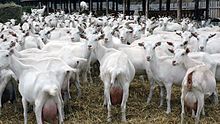



Goat milk is the milk of domestic goats. Goats produce about 2% of the world's total annual milk supply.[1] Some goats are bred specifically for milk. Goat milk naturally has small, well-emulsified fat globules, which means the cream will stay in suspension for a longer period of time than cow's milk; therefore, it does not need to be homogenized. Eventually, the cream will rise to the top over a period of a few days. If the milk is to be used to make cheese, homogenization is not recommended, as this changes the structure of the milk, affecting the culture's ability to coagulate the milk as well as the final quality and yield of cheese.[2]
Dairy goats in their prime (generally around the third or fourth lactation cycle) average—2.7 to 3.6 kg (6 to 8 lb)—(or 2.8 to 3.8 L (3 to 4 U.S. qt))—of milk production daily—roughly during a ten-month lactation. Goats produce more after freshening and gradually drop production toward the end of their lactation. The milk generally averages 3.5% butterfat.[3]
- ^ FAO. 1997. 1996 Production Yearbook. Food Agr. Organ., UN. Rome, Italy.
- ^ Amrein-Boyes, D. (2009). 200 Easy Homemade Cheese Recipes. Robert Rose Inc.: Toronto
- ^ American Dairy Goat Association, adga.org